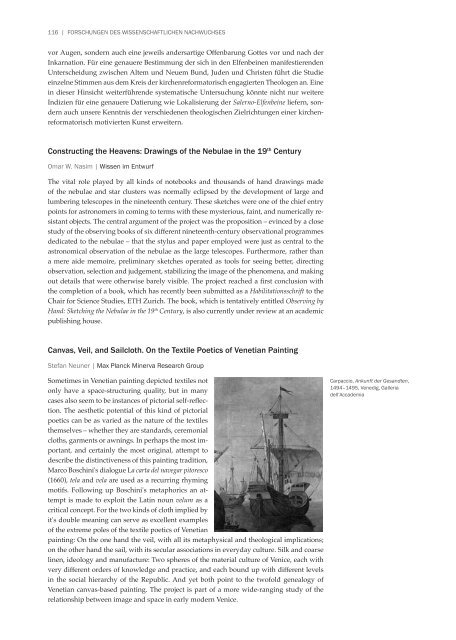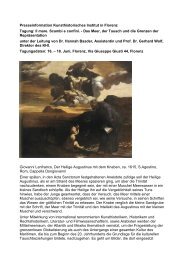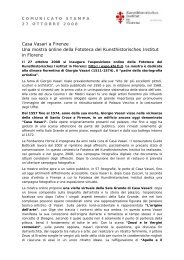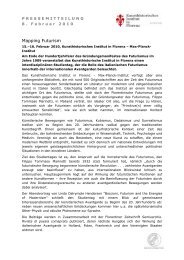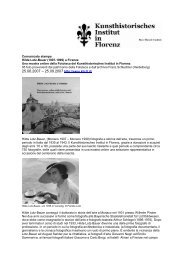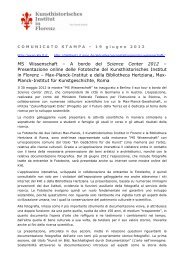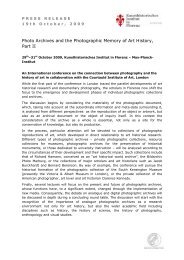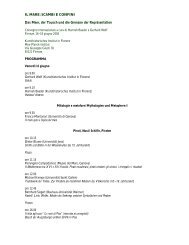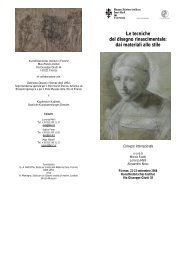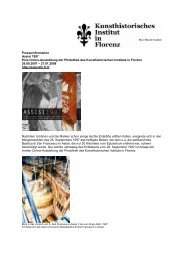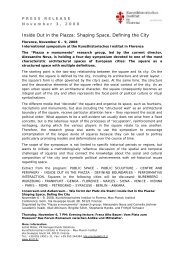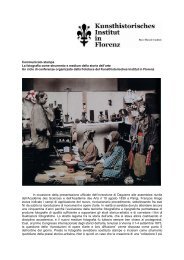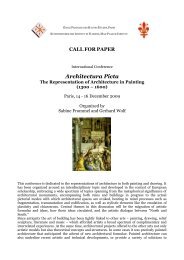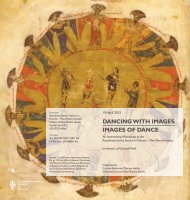forschungsbericht november 2008 – juli 2012 - Kunsthistorisches ...
forschungsbericht november 2008 – juli 2012 - Kunsthistorisches ...
forschungsbericht november 2008 – juli 2012 - Kunsthistorisches ...
Sie wollen auch ein ePaper? Erhöhen Sie die Reichweite Ihrer Titel.
YUMPU macht aus Druck-PDFs automatisch weboptimierte ePaper, die Google liebt.
116 | FORSCHUNGEN DES WISSENSCHAFTLICHEN NACHWUCHSES<br />
vor Augen, sondern auch eine jeweils andersartige Offenbarung Gottes vor und nach der<br />
Inkarnation. Für eine genauere Bestimmung der sich in den Elfenbeinen manifestierenden<br />
Unterscheidung zwischen Altem und Neuem Bund, Juden und Christen führt die Studie<br />
einzelne Stimmen aus dem Kreis der kirchenreformatorisch engagierten Theologen an. Eine<br />
in dieser Hinsicht weiterführende systematische Untersuchung könnte nicht nur weitere<br />
Indizien für eine genauere Datierung wie Lokalisierung der Salerno-Elfenbeine liefern, sondern<br />
auch unsere Kenntnis der verschiedenen theologischen Zielrichtungen einer kirchenreformatorisch<br />
motivierten Kunst erweitern.<br />
Constructing the Heavens: Drawings of the Nebulae in the 19 th Century<br />
Omar W. Nasim | Wissen im Entwurf<br />
The vital role played by all kinds of notebooks and thousands of hand drawings made<br />
of the nebulae and star clusters was normally eclipsed by the development of large and<br />
lumbering telescopes in the nineteenth century. These sketches were one of the chief entry<br />
points for astronomers in coming to terms with these mysterious, faint, and numerically resistant<br />
objects. The central argument of the project was the proposition <strong>–</strong> evinced by a close<br />
study of the observing books of six different nineteenth-century observational programmes<br />
dedicated to the nebulae <strong>–</strong> that the stylus and paper employed were just as central to the<br />
astronomical observation of the nebulae as the large telescopes. Furthermore, rather than<br />
a mere aide memoire, preliminary sketches operated as tools for seeing better, directing<br />
observation, selection and judgement, stabilizing the image of the phenomena, and making<br />
out details that were otherwise barely visible. The project reached a first conclusion with<br />
the completion of a book, which has recently been submitted as a Habilitationsschrift to the<br />
Chair for Science Studies, ETH Zurich. The book, which is tentatively entitled Observing by<br />
Hand: Sketching the Nebulae in the 19 th Century, is also currently under review at an academic<br />
publishing house.<br />
Canvas, Veil, and Sailcloth. On the Textile Poetics of Venetian Painting<br />
Stefan Neuner | Max Planck Minerva Research Group<br />
Sometimes in Venetian painting depicted textiles not<br />
only have a space-structuring quality, but in many<br />
cases also seem to be instances of pictorial self-reflection.<br />
The aesthetic potential of this kind of pictorial<br />
poetics can be as varied as the nature of the textiles<br />
themselves <strong>–</strong> whether they are standards, ceremonial<br />
cloths, garments or awnings. In perhaps the most important,<br />
and certainly the most original, attempt to<br />
describe the distinctiveness of this painting tradition,<br />
Marco Boschini's dialogue La carta del navegar pitoresco<br />
(1660), tela and vela are used as a recurring rhyming<br />
motifs. Following up Boschini's metaphorics an attempt<br />
is made to exploit the Latin noun velum as a<br />
critical concept. For the two kinds of cloth implied by<br />
it's double meaning can serve as excellent examples<br />
of the extreme poles of the textile poetics of Venetian<br />
painting: On the one hand the veil, with all its metaphysical and theological implications;<br />
on the other hand the sail, with its secular associations in everyday culture. Silk and coarse<br />
linen, ideology and manufacture: Two spheres of the material culture of Venice, each with<br />
very different orders of knowledge and practice, and each bound up with different levels<br />
in the social hierarchy of the Republic. And yet both point to the twofold genealogy of<br />
Venetian canvas-based painting. The project is part of a more wide-ranging study of the<br />
relationship between image and space in early modern Venice.<br />
Carpaccio, Ankunft der Gesandten,<br />
1494<strong>–</strong>1495, Venedig, Galleria<br />
dell‘Accademia


